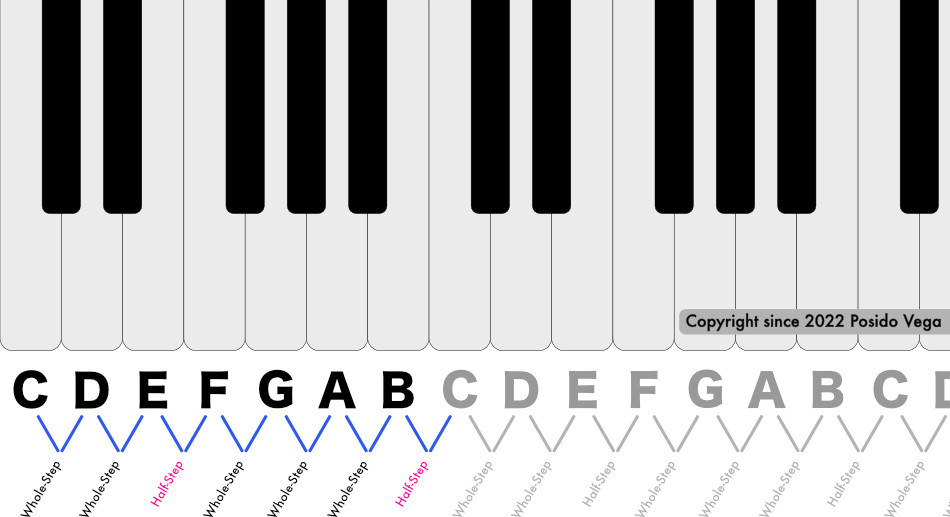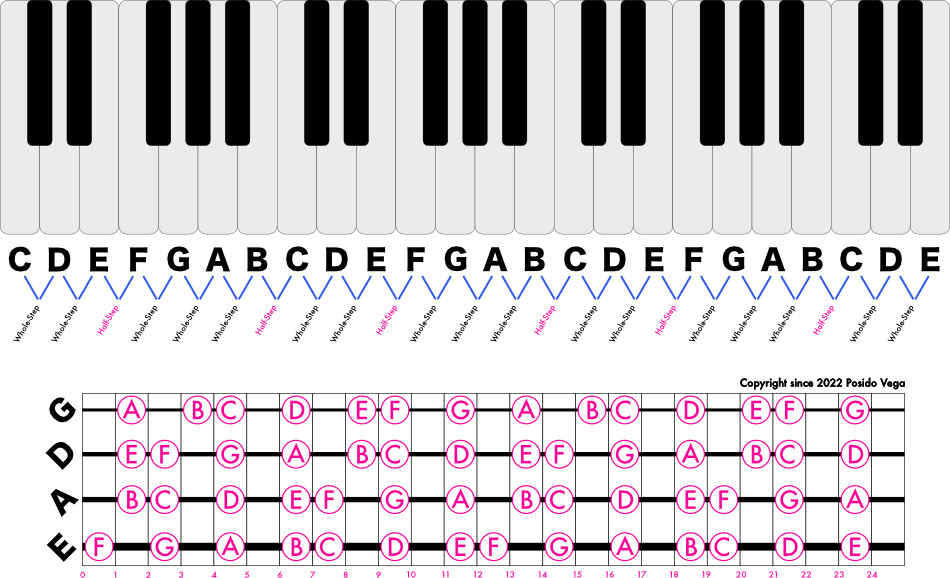As a seasoned content creator at guitarplayers.net and a dedicated bass educator, I’ve encountered countless aspiring bassists, from fresh beginners to players with years under their fingers, who grapple with a fundamental challenge: knowing all the notes across their bass guitar fretboard. It’s a hurdle that, once cleared, unlocks a new dimension of musical understanding and expression.
Learning the notes on your bass guitar isn’t an insurmountable task. In fact, with the right approach, it can be a surprisingly efficient journey. The fretboard isn’t a random arrangement; it’s built on a logical system. Understanding this underlying logic is the key to unlocking the fretboard and truly knowing your instrument.
In this expanded guide, we’ll delve deeper than ever before into:
- A step-by-step method to learn every note on the bass fretboard, designed for rapid understanding and retention.
- Clear explanations of musical intervals and fretboard mechanics.
- Practical strategies to apply your knowledge in real musical scenarios.
Let’s embark on this journey to master the Notes On The Bass Guitar and transform your playing.
Your 4-Step System to Fretboard Mastery
My method to learn every note on the bass guitar fretboard is structured around four core steps, designed for clarity and ease of learning:
- Grasp the Interval Logic of Notes: Understand the fundamental building blocks of musical notes – whole steps and half steps.
- Decipher the Logic of the Bass Fretboard: Apply interval knowledge to the layout of the bass guitar neck.
- Utilize Octaves as Fretboard Landmarks: Learn octave shapes to navigate the fretboard efficiently.
- Apply Your Knowledge in Musical Contexts: Put your fretboard understanding into practice through playing and exercises.
For quick reference, especially for beginners, bookmark this page to revisit these steps as you progress in learning the notes on your bass.
Step 1: Decoding the Interval Logic of Musical Notes
Western music, in most of its forms, operates within a system of just 12 unique notes. Mastering these 12 notes is your first crucial step. The most efficient way to learn them is by understanding the logical sequence in which they are arranged, one note at a time.
Key Insight: Musical notes follow an alphabetical sequence. If you’re comfortable with the alphabet, specifically from A to G, you’re already well-prepared.
The notes A, B, C, D, E, F, and G are the foundation. These are often referred to as natural notes and correspond to the white keys on a piano.
This sequence repeats continuously across all instruments and octaves: A, B, C, D, E, F, G, A, B, C, D, E, F, G, and so on.
The remaining five notes are the sharps and flats, the inflections that exist between the natural notes: A♯/B♭, C♯/D♭, D♯/E♭, F♯/G♭, and G♯/A♭. On a piano, these are represented by the black keys nestled between the white keys.
Notice that sharps and flats have dual spellings – this is known as enharmonic spelling. While the pitch remains the same, the spelling can change depending on the musical context. For now, focus on recognizing the notes; the nuances of spelling will become clearer as you advance.
Whole Steps and Half Steps: The Distance Between Notes
Observe a piano keyboard, and you’ll see black keys positioned between most white keys, with two exceptions.
Crucial Tip: There’s no black key separating E and F, nor between B and C. This principle holds true on the fretboard of your bass guitar as well!
 Piano keys – Whole-Step and Half-Step Diagram
Piano keys – Whole-Step and Half-Step Diagram
Piano keys – Whole-Step and Half-Step Diagram
The interval between E and F is always a half-step (equivalent to one fret on the bass). Similarly, the interval between B and C is also a half-step (one fret).
All other natural notes are separated by a whole step (equivalent to two frets).
Let’s immediately apply this understanding to your bass guitar. This method is far more intuitive than simply trying to memorize notes in a chromatic sequence.
Step 2: Unraveling the Bass Guitar Fretboard Logic
Building upon our understanding of intervals, let’s recap the essential principles:
- Musical notes are alphabetically ordered.
- E-F and B-C are always a half-step apart (one fret).
- All other natural notes are a whole-step apart (two frets).
Here’s the fundamental fretboard logic to internalize:
- Each fret on your bass fretboard represents a half-step.
- Two frets equal a whole step.
On a standard four-string bass guitar, the open string notes.) are E, A, D, and G, from the thickest to thinnest string.
 Bass Guitar Fretboard Notes and Piano Notes Diagram
Bass Guitar Fretboard Notes and Piano Notes Diagram
Bass Guitar Fretboard Notes and Piano Notes Diagram
Let’s begin with the lowest string, the E string. Learning the notes string by string is an effective approach.
Remember, E-F and B-C are the only natural note pairs without an intervening sharp or flat.
Finding the Notes on Your E-String (The Easy Way)
Starting with the open E-string, the first fret is F (a half-step up from E).
Applying the logic of musical intervals, we can map out all the natural notes on the E string:
- Two frets above F is G (whole step).
- Two frets above G is A (whole step).
- Two frets above A is B (whole step).
- One fret above B is C (half step).
- Two frets above C is D (whole step).
- Two frets above D is E (whole step).
- And the pattern repeats.
Let’s transfer this knowledge to the next string, the A-string.
Finding the Notes on Your A-String (The Easy Way)
The note positions on the A-string follow the same interval pattern:
- Two frets above A is B (whole step).
- One fret above B is C (half step).
- Two frets above C is D (whole step).
- Two frets above D is E (whole step).
- One fret above E is F (half step).
- Two frets above F is G (whole step).
- Two frets above G is A (whole step).
- Again, the pattern repeats.
Let’s continue and locate the natural notes on the D-string.
Finding the Notes on Your D-String (The Easy Way)
The D-string notes unfold in a similar fashion:
- Two frets above D is E (whole step).
- One fret above E is F (half step).
- Two frets above F is G (whole step).
- Two frets above G is A (whole step).
- Two frets above A is B (whole step).
- One fret above B is C (half step).
- Two frets above C is D (whole step).
- The pattern continues to repeat.
Just one string left! Let’s discover the notes on the G-string.
Finding the Notes on Your G-String (The Easy Way)
The G-string notes are located as follows:
- Two frets above G is A (whole step).
- Two frets above A is B (whole step).
- One fret above B is C (half step).
- Two frets above C is D (whole step).
- Two frets above D is E (whole step).
- One fret above E is F (half step).
- Two frets above F is G (whole step).
- And the pattern repeats itself.
Now, let’s accelerate your learning by exploring octaves!
Step 3: Leveraging Octave Shapes for Fretboard Navigation
This step is pivotal in speeding up your fretboard knowledge. Octaves function as signposts across the fretboard. While other intervals can also serve this purpose, octaves are particularly useful for beginners because they represent the same note at a different pitch, simplifying recognition.
A perfect octave is a note at the same pitch but double (or half) the frequency.
There are multiple octaves of any given note across your bass fretboard. Learning their locations is invaluable.
Seek them out along the neck of your bass.
Bass Guitar Fretboard Octaves Diagram
Here are some easily memorized octave shapes:
- Move two frets higher and up two strings to find an octave higher.
- Move two frets lower and down two strings to find an octave lower.
- Move three frets lower and up three strings to find an octave higher.
- Move three frets higher and down three strings to find an octave lower.
- Move five frets lower and up one string to find an octave higher.
- Move five frets higher and down one string to find an octave lower.
- Move seven frets higher and up one string to find an octave higher.
- Move seven frets lower and down one string to find an octave lower.
Step 4: Real-World Application for Rapid Learning
While the first three steps provide the knowledge base, Step 4, applying this logic and using octaves as guides, is what truly accelerates your learning.
Key Practice: There’s no substitute for playing your bass and actively applying your knowledge.
Consistent practice is essential. The more you apply these principles, the more intuitively the notes will become, and fretboard mastery will come sooner than you expect.
Incorporate exercises into your practice routine where you identify notes, play scales, and learn simple bass lines. Use a metronome to develop timing while you practice note recognition. A great exercise is to play a bass line and then immediately play it an octave higher, consciously finding the octave shape as you play.
This active application solidifies your fretboard knowledge and makes finding notes second nature.
(Bonus) Step 5: Verbal Reinforcement Through Note Names
To further solidify your learning, dedicate a few minutes in each practice session to verbally naming each note you play.
Practice slowly, prioritizing accuracy over speed.
The goal is accurate recognition, not rapid playing.
This technique is remarkably effective for quickly internalizing the notes on the bass. A practice I used frequently was to say the note name, locate it on the fretboard, and then play it. When I was learning to read standard music notation, verbally reciting note names reinforced their fretboard positions.
I extended this practice to band rehearsals, jam sessions, and even live performances. This way, I was learning dynamically, in real musical time.
This forced on-the-fly thinking was a significant confidence booster, especially when I was starting out on the bass.
Your Turn to Play
All the theoretical understanding of fretboard logic and octave shapes is valuable, but its true worth emerges when you translate it into practical playing.
Learning your bass guitar notes is fundamental for improvisation, music reading, and playing along to chord charts while maintaining rhythm.
So, begin applying what you’ve learned today, and you’ll see tangible progress in weeks.
For more in-depth bass lessons and resources, explore My Sandbox for a wealth of learning materials.
Frequently Asked Questions
What are the Notes on a Bass Guitar in Standard Tuning?
On a standard 4-string bass guitar, the strings are tuned to the notes E, A, D, and G.
For a 5-string bass, the tuning extends lower, with string notes of B, E, A, D, and G.
A 6-string bass expands further, adding a high C string, resulting in B, E, A, D, G, and C.
Standard bass tuning is in fourths, meaning the interval between each open string is a perfect fourth. Understanding fourth intervals, similar to octaves, provides another helpful pattern for navigating notes across strings and is a valuable concept to explore as you continue your bass journey.
What’s the Most Effective Way to Memorize Bass Guitar Notes?
A common question is, “How do I memorize the notes on the bass?”
My answer is always, “You don’t primarily memorize them, you learn the system.”
It’s far more effective to understand the underlying logic of note intervals and the fretboard layout. Once you grasp this logic, the positions of notes become intuitive and make sense within the framework of your understanding.
Cultivate good habits, such as recognizing patterns and shapes and verbally naming notes during practice. Trust in the process of learning and application.
True memorization emerges naturally as you build connections and find meaning in the information you are learning. Recognizing patterns and shapes is a key way to establish these mental connections.
How Do I Find Any Note on the Bass Guitar?
To find any note on your bass guitar, you must understand the instrument’s fretboard construction. A 4-string bass in standard tuning has strings E, A, D, and G. The fretboard’s layout mirrors the logic of a piano keyboard. Natural notes are a whole step apart, except for E and F (half step) and B and C (half step). All other natural note pairs are separated by a whole step. By understanding this interval structure and the open string notes, you can systematically locate any note on the fretboard.

